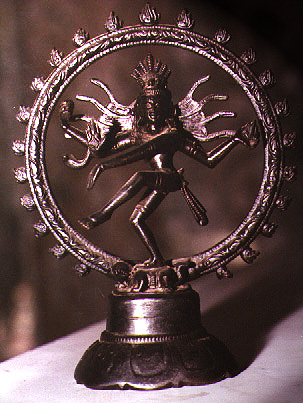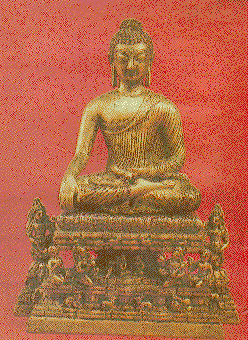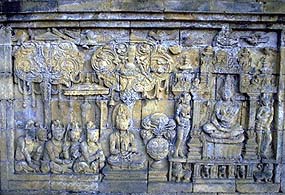Swagatam
(Welcome in Sanskrit)
Ancient India's Contribution to Our World's Material (Temporal) Culture
This Site is dedicated to the Unity and Integrity of Humankind
Vasudhaiva Kutumbakam
(The World is one family - an ancient Vedic term)
by Sudheer Birodkar
Dear Visitor,
Here goes a Sloka (couplet) from the Atharva Veda (one of the 4 Vedas - treatises on knowledge from ancient India) which embodies the true spirit of humanness expressed, not today, but four thousand years ago.
We are the birds of the same nest,
We may wear different skins,
We may speak different languages,
We may believe in different religions,
We may belong to different cultures,
Yet we share the same home - OUR EARTH.
Born on the same planet
Covered by the same skies
Gazing at the same stars
Breathing the same air
We must learn to happily progress together
Or miserably perish together,
For man can live individually,
But can survive only collectively
It is this spirit of humanness that has been the undercurrent of existence in a part of the world known by many names like Aryavarta, Jambudwipa, Bharatvarsha, Hindustan or India. This spirit has also prevailed in many other parts of the world where the right thinking of humankind has prevailed.
In India, this spirit has found expression in the philosophy of non-violence, religious tolerance, renunciation - in non-temporal matters. In temporal matters, which is the subject of this book, it has found expression in achievements in all areas of science and technology. Achievements which did not remain limited to India alone, but were transmitted to many corners of our globe.
These achievements are not just a matter of pride for Indians alone. They represent the triumph of the human mind and hence are a matter of pride for the human species irrespective of nationality.
But over a period of one thousand years of a dark age, this spirit of humanness was dormant in India; eclipsed as it was under influences which came from the deep recesses of the malevolence in the human mind. That these influences were embodied in invaders from other parts of the globe is only incidental.
This setback could have as well been caused by internal upheavals that could have brought about malevolent influences to the fore as in imaginary cases if the Kauravas had triumphed over the Pandavas in the Mahabharat war or if Kansa had slayed Krishna at Mathura. These possibilities are hypothetical but what happened when the spirit of humanness was trampled under the feet of invaders who brought in intolerance, persecution, forced conversions of people, destruction of places of worship, penal taxes, and a general political tyranny; could have as well taken place in some altered pattern under domestic malevolent factors embodied in say Duryodhana or Kansa.
So rather than grieving in the fact that these malevolent influences came from beyond India�s geographic boundaries, we need to rejoice in the fact that even in these compelling circumstances, the spirit of humanness was only dormant but did not become extinct. As Arthur Basham, the famous Australian Historian says, "The ancient civilisation of India differs from those of Egypt, Mesopotamia and Greece, in that its traditions have been preserved without breakdown to the present day".
Today after a gap of one thousand years, the spirit of humanness can again breathe freely and it is about time that we recollect it and the successes it propelled the human mind to achieve. The human mind embodied in the ancient sages, rishis, munis and sanyasis - scientists in modern parlance.
We need to remember our past clearly and vividly, lest we forget, our capability to contribute to the repository of human knowledge, lest we forget our capability to activate the indomitable human mind residing within us, lest we forget our humane instincts that gave us a sagacious and charitable view of life along with progress - economic, technological and material. All that which goes under the term CIVILIZATION.
The human spirit in Ancient India has given to the world, the values of non-violence, religious tolerance, renunciation alongwith many elements of knowledge in fields like production technology, mechanical engineering, shipbuilding, navigation, architecture, civil engineering, medical science, physics, chemistry, logic, astronomy, mathematics and so on.
The following paragraphs and pages of this book will take you into the various fields where this indomitable spirit had exercised itself, in what is geographically today India, to leave behind a legacy which belongs not to Indians alone but to all humans. A legacy that can help human beings in all corners of our globe to rejuvenate our spirit not to conquer one another, but to conquer oneself; not to destroy, but to build; not to hate, but to love; not to isolate oneself, but to integrate everyone into one global society and to achieve much more in the future to enrich human civilisation to result in:
"The maximum welfare of the maximum number" or as in Sanskrit it is called:
"Loko Samasto Sukhino Bhavantu" and "Samasta Janaanaam Sukhino Bhavantu." This book will tell you how and why words (and the products behind those words) like Cash, Sugar, Camphor etc., originated from ancient India. It is corroborated in the Oxford Dictionary that the English Word "Cash" originated from the Sanskrit term "Karsha". Sanskrit was the classical language of ancient India.
Such words in the English language are for products like Sugar, Cotton (cloth), Camphor, Lac, Glass, Alloys of Metals (e.g. Brass). Now these products are not gifts of nature. Their manufacturerequires machinery (apparatus), some knowledge of chemical engineering. The fact that these products were manufactured in ancient India, presumes that in those times Indians had some apparatus in place, and some knowledge of chemical engineering.
Other examples of elements of material culture and civilization that originated in ancient India and which the world owes to the genius of ancient Indian scientists and inventors include: - the technique of algorithm used in computer science today. - the science of algebra. - the concept of zero - on which ultimately rests the binary code which has given us all software including the WWW through which you are accessing this site! - the technique of manufacturing crystal (sugar)cane sugar (the word sugar is derived from the Sanskrit term "Sharkara"). - the making of camphor (this word is derived from the Sanskrit root word "Karpuram" according to the Oxford Dictionary). - the making of tin (the technical English word for tin is Cassiterite which is said to have been derived from the Sanskrit term "Kasthira"). - The making of dyes like Anline and Indigo (the word Indigo comes from the term India and the word Anline is derived from the Arabic term An Nil which is derived from the Sanskrit term Neelam, according to the Oxford dictionary). - the Gumbaz that we see on mosques all over the world originated as the interlocking dome in the "Stupa" of the Buddhist architectural tradition of India. �
There are many such instances in the virtually all fields. Be it civil engineering, architecture, mechanical engineering, production technology, chemical engineering, physics, medical science, mathematics, logic, astronomy, or be it shipbuilding, navigation, the fine arts, etc. There are evidences that many elements in all these varied aspects of today's global civilization owe their origin to ancient India!! Yes read more about this in the book "India's Contribution to World Culture" by Sudheer Birodkar

Shiva-Nataraja - the Indian God of Dance.Shiva, along
with Brahma and Vishnu forms the Hindu Trinity or Trimurti

Buddhism preached non-violence towards all living beings
It exercised a sobering influence over a large part of South-east Asia and Central Asia.

It is in temple
panels such as this one that the splendour of� Indian temple architecture has been
immortalised� into granite

This panel is from Borobodur in Indonesia.
Borobudur means "Big Buddha" Buddhism preached the values of charity,�
piety and renunciation in addition to Jivadaya i.e. non-violence towards all living forms.

Coinage dating from the 8th Century
B.C.� to the17th Century A.D.� Numismatic evidence of the advances� made by
Smelting technology in ancient India�

This is a graphic depiction� of the
calculation of eclipses in a text called, Pancha-Siddhantika dated around� the
5th Century A.D.

An artist's rendering of an operation being
performed in ancient times�
�